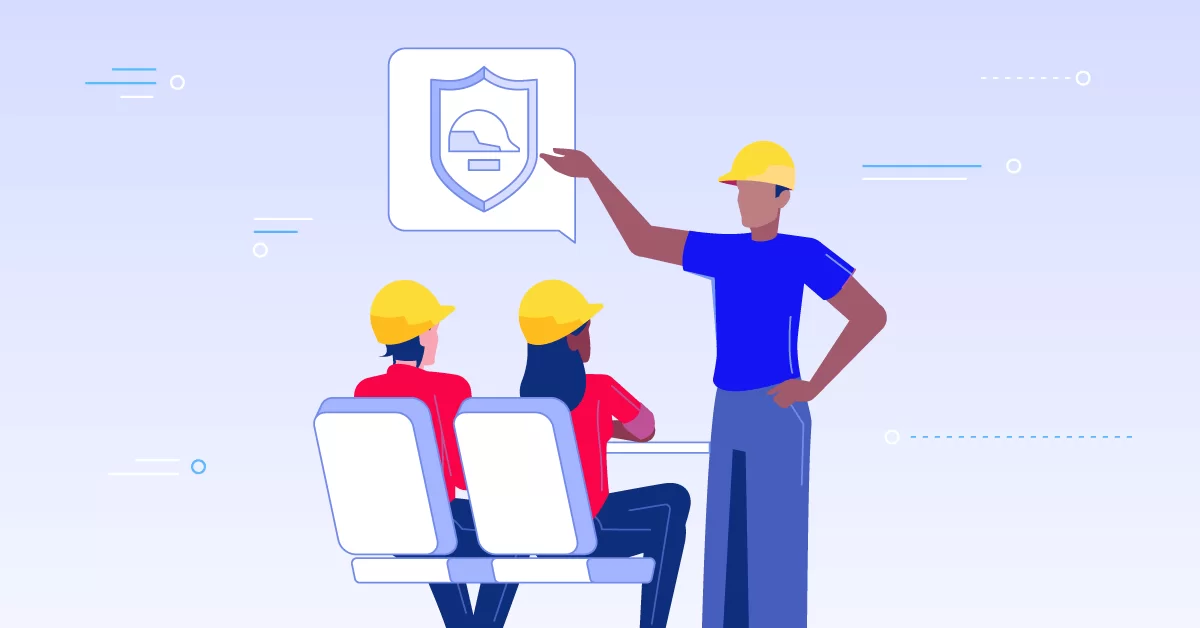After all what’s the harm in allowing employees a few months to get up to speed, when you compare it to the 30 plus years that they’d work for the company? Sufficient employee onboarding training could only do everyone good: the employees, the employer and the business itself!
But, that, as they say, was then, and this is now.
Hitting the ground running
In today’s competitive economic landscape, businesses can’t really afford to have new employees learn on the job. And there are many reasons why companies can’t afford to provide sometimes even not the basic new hire training program.
First and foremost, because neither companies nor employees are that loyal anymore.
Neither companies nor employees are that loyal anymore.Share on
Some of the them might just be seasonal hires, that need to be trained and productive “by yesterday” to help offload your regular personnel. Others, especially in sectors with plenty of working opportunities such as IT, are not gonna be around for more than 4-5 years before they start to look elsewhere for their next career move.
In both cases, getting new employees productive pronto makes a lot of sense in terms of savings and increased productivity (especially if one considers that, according to some estimations, the cost of replacing an employee can reach 50% of their annual salary).
There’s also the fact that the modern ecommerce opportunities gave mistakes the potential to be costlier than ever. And with online and social media ready to jump on the first sign of a good story, certain employee mistakes that would go unnoticed in the past, can cause a huge embarrassment (and loss of sales) to a company.
These are just some of the reasons that conspired to make employee onboarding a big deal in the last decade (we’ll get into a few more later in this post), and had businesses search for ways to make their employee onboarding and orientation processes more efficient.
eLearning, especially in the form of modern web based learning management systems (LMS), has been the obvious answer to those needs. And I say obvious, because, after all, what is an onboarding process if not a special case of employee training meant for new hires?
The duration of an onboarding course might be shorter, and its content might be less challenging than a regular training course (and not entirely job related as we’ll see), but it’s still the same process, and an eLearning system is ideally suitable for it.
But before we get into how enterprises can leverage eLearning for employee orientation and new hire training, let’s first have a look at the contents of a typical employee onboarding course.
What are the must-haves of online onboarding programs
While enterprise training needs can be many and varied, ranging from training your franchise partners to make the perfect McBurger to air-force training for F-16 pilots, employee onboarding courses tend to be much more similar in scope and content between organizations.
Regardless of your line of business, for example, the goal of any employee onboarding program is to help new hires integrate smoothly in your company.
So, what should onboarding new employees look like?
Leverage your employee onboarding program to introduce them to their new working environment and give them the basic information that they need in order to start being productive.
So, what should onboarding new employees look like?Share on
The first thing they’ll need to know is what their responsibilities are, along with their place in your enterprise’s organizational chart (in other words, who their colleagues and bosses are), as those are the very things that define their professional role.
You’ll also need to inform them about your organization’s operating procedures and policies, and also about any legal restrictions and guidelines that they’ll need to follow.
If we’re talking about simple seasonal hires or unskilled employees that will only be handling some small and well defined part of your business (e.g. freight loading, burger flipping etc.), that much orientation, perhaps combined with an equally to the point training program detailing the skills they need to have, might be more than enough to call it a day.
Obviously the training needs of new hires are different when you’re dealing with a retail employee versus a VIP level executive or an engineer.
For employees that are meant for more advanced roles, and especially for people that are meant to be with the company for the long term, the onboarding program would be best to get them to see the bigger picture, to help them understand how they fit in into it, and this means an extended (in breadth and time) training program.
Giving your new hires a brief history of the company and explaining its range of operations, its customer base, and its core values would be a good place to start.
You could then continue with some (very useful for new employees) information about career advancement prospects in your company, your corporate culture, and all the benefits and perks available (including health & life insurance, pension plans, etc).
Depending on the job market, and how hard it is to get talent for your particular industry, you might have to make your onboarding course more retention oriented (as opposed to orienting it to quick productivity).
Especially in certain fields such as IT and Finance, talent acquisition can be hard, and an employee’s first impression of a company during his first few months on the job has been shown to play an important role to their decision to stay there. That’s why it’s important for your orientation/onboarding program to help new hires feel that they’re welcome, that they’re part of something bigger, and that they have made the right career choice.
Now, unless your CEO is called Steve Jobs (or maybe Elon Musk), or is a regular speaker at industry conferences, don’t bother with some long winded “message from the CEO” — your employees are gonna skip it anyway. If you want to have one, keep it short and to the point.
"Don'tShare on
That said, offering some real life working experiences and advice from your existing employees would be a nice way to give your new hires a sense of what would be like working for your company.
For work in IT, or involving computers (so, almost all of them), an introduction to your organization’s intranet and web facilities should also be included in your onboarding material. That’s especially crucial if your company has a BYOD policy, in which case you’ll also need to include some setup guides (e.g. for employees to configure their email program, or to connect their laptop to your VPN).
Your employee onboarding program should also teach the professional and industry best practices regarding customer support, data privacy, etc., as well as any industry or government mandated rules and regulations (e.g. regarding labor safety, environmental protection, etc.).
Last, but not least, another thing that should definitely be in your employee onboarding checklist is training regarding sensitive legal and social issues such as sexual harassment and racial discrimination, so that your employees are aware of the correct codes of conduct for these situations.
The benefits of eLearning based onboarding
There are several key benefits of implementing your employee onboarding program with an eLearning management system (LMS), besides the fact that it’s what all the big boys do.
1) It helps you formalize your onboarding process and material. This makes onboarding a more well-defined and repeatable process, than having someone showing new hires around the office and giving them a prep talk and a few brochures that they’ll never read.
Of course your managers should come down with well defined roles and clear expectations and goals for new hires, and assist your eLearning instructors to put them in writing.
2) Being repeatable and automated, means it only incurs a one-time cost in order to create the onboarding course materials, which from then on can be maintained and re-applied whenever the need arises, with minimal overhead.
3) Choosing web based onboarding is easy! You leverage your existing LMS infrastructure, which means that you can run your onboarding process as a regular training program, complete with tests and reports to verify its effectiveness.
This is an option that you don’t have when you use a regular content management system (CMS) for your onboarding. This ability to monitor and track an onboarding program’s progress has been shown to be crucial in its success.
Another useful option with eLearning based onboarding, is that you can also your LMS to evaluate your new hires (through quizzes, tests, etc) and their aptitude for different kinds of tasks. This can complement your hires’ initial evaluation from your interviewers and HR people, and help you determine what roles and responsibilities you should assign them.
4) As eLearning is asynchronous, your onboarding can take place at the time that best fits your business needs and employees schedule, which is good both for minimizing business downtime and disruption and employee satisfaction.
Your new employees will be able to take an eLearning orientation course at their own pace, while still getting on with everything else that they have to do during their first weeks or months.
5) Unlike regular classroom based onboarding and new hire training programs, online employee onboarding doesn’t require multiple instructors, scheduled classes, transportation and other such expenses. In fact the same onboarding program can be server from your LMS platform to employees all over the world, 24/7.
6) With LMS based onboarding your new employees can go straight from their onboarding/orientation program to a full-on new hire training program, while using the same web-based environment they’re already familiar with.
7) While some of it might be fluff, a lot of onboarding/orientation material consist of things that your employees will need to consult again as time goes by (e.g. regulations, organizational charts, IT guides, etc.). With LMS based onboarding, these materials will be available online in a formal and easily accessible format.
In fact an LMS allows you to have your onboarding material serve as part of your organization’s recruiting strategy by making the same information about your company’s structure, corporate culture, work experiences, perks and benefits etc., available either to the public at large (e.g. as part of your public facing portal) or just to potential hires.
This will help raise excitement about your working environment and the career opportunities that you offer, and is a strategy that many big companies follow, from Google and Facebook to Pixar.
8) Last but not least, an eLearning based orientation course can use the LMS system to track attendance and completion status. In case of dispute, this can serve as a legal proof that your company has indeed provided knowledge of things like company policy, sexual harassment laws, etc, to the new hire (of course your regional laws may vary, so consult your legal department on this).
Blend it
Should onboarding eLearning courses be the only way to deliver your training?
Should onboarding eLearning courses be the only way to deliver your training?Share on
While eLearning based onboarding is great in all the aforementioned ways, and an improvement over the costly and ad-hoc onboarding processes of yore (of their lack thereof), onboarding shouldn’t be relegated only to the online realm.
An effective employee onboarding program will also need some physical presence, from the classic “tour around the office” where new hires can meet and greet their new colleagues, to specialized training sessions were physical skills are important (e.g. how to operate some machinery).
A modern LMS platform like eFront has you covered here too, as it provides support for blended learning, allowing you to schedule and treat physical training sessions, meetings and seminars the same way as your web based lessons.
Get onboard
In this post we’ve had a look at the basics of employee onboarding and new hire training, and examined how eLearning software not only helps you increase onboarding effectiveness and minimize costs, but also affords several unique opportunities over traditional onboarding techniques.
If you’re looking for a modern, web based, eLearning platform for your employee onboarding and training needs, you don’t have to look any further than our own industry leading eFront LMS.
With over a decade of development, and now in its fourth version, eFront is well known for its ease of use, excellent support and extensive feature list, from Reporting and Instructor-Led-Training support to a full blown extension API and REST interface.
Take eFront for a test drive, with your own account, and get your company onboard with employee onboarding today!



